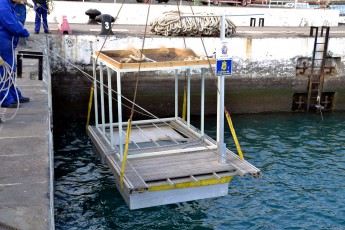 In recent years it has proven to, after a long time, copies of terns have returned to the island of Gran Canaria to build their nests.
In recent years it has proven to, after a long time, copies of terns have returned to the island of Gran Canaria to build their nests.
The Minister of Environment and Emergencies of the Cabildo de Gran Canaria, Mary of the Sea Arévalo, and the captain and chief of the Arsenal of Las Palmas, Juan González-Aller, have announced today the system devised by technicians from the Navy and the Department of Environment which aims to make the common tern (Sterna hirundo) have your space for breeding on the coast of Las Palmas.
Before there was a colony of terns in southern Gran Canaria. Hundreds of individuals were counted were gradually leaving the island territory under pressure from tourism development and predators like cats, rats and dogs.
Currently only visit the island about five breeding pairs who have chosen Arsenal docks and the Club Nautico de Gran Canaria to build their nests. In other port areas of the city, as in the Muelle Reina Sofía, They have also been detected breeding pairs of common terns in very small numbers.
 The Common Tern is a migratory bird species with a remarkable sense of territoriality during breeding season. Defends the nest very aggressively and with great determination. After settling on the coast of Gran Canaria's capital seven years ago, there have been direct attacks on people who were passing near the eggs or chicks.
The Common Tern is a migratory bird species with a remarkable sense of territoriality during breeding season. Defends the nest very aggressively and with great determination. After settling on the coast of Gran Canaria's capital seven years ago, there have been direct attacks on people who were passing near the eggs or chicks.
In order to avoid risks for people and, at the same time, ensure conservation of the species through the establishment of a colony of terns in Gran Canaria, technicians of the council have proposed the installation of a floating platform in the waters of the Naval Base where the terns can nest safely and tranquility.
The structure is located between West Pier and the breakwater of Marine Avenue which generates no interference with the operation of vessels. It has also been sought that is not very close to the shore to prevent terns attack passersby boardwalk.
Biologists consider terns likely to start using that platform and, to checking their suitability and lack of discomfort, in the future breeding tasks are moved there to do.
The surface of the growing area of the platform carries a substrate sand and gravel, as well as other elements that resemble the natural environment in which these birds breed and also allows chicks blend, protected from the sun and hide from their main predator: seagulls.
To force the colonization of the artificial enclave there are strategies such as placing tern decoys constructed with plaster and claims issuing common tern in their breeding colonies through an audio.
Such experiences to implement breeding pairs of common terns in conflict zones are extensively described in northern Spain, where it has managed to establish colonies on artificial platforms in the Bay of Santander and in other European countries.
A level of legal protection, common tern statewide included in the List of Wild Species in Special Protection Regime and the Catalog of Endangered Species (Royal Decree 139/2011).
As for the Endangered Species Catalog Canario (Law 4/2010), tern is framed in Annex VI, included in the category of species of special and affected Interest Section 4 the Single Transitional Provision. In the Red Book of Birds of Spain it is considered as "Near Threatened".
Productivity of couples set at Arsenal has been monitored by ornithologist Rafael Mucientes that, today, He works as chief engineer on the boat Customs Surveillance based on own Naval Base.

